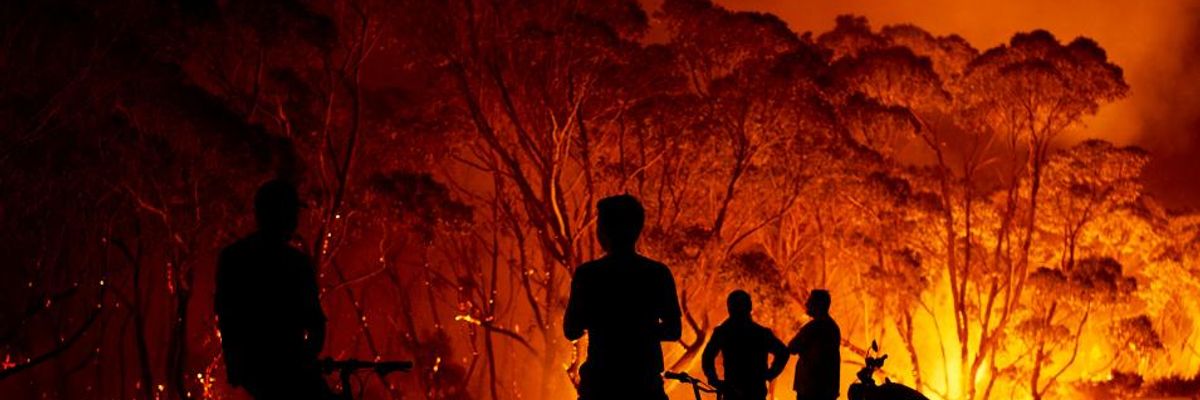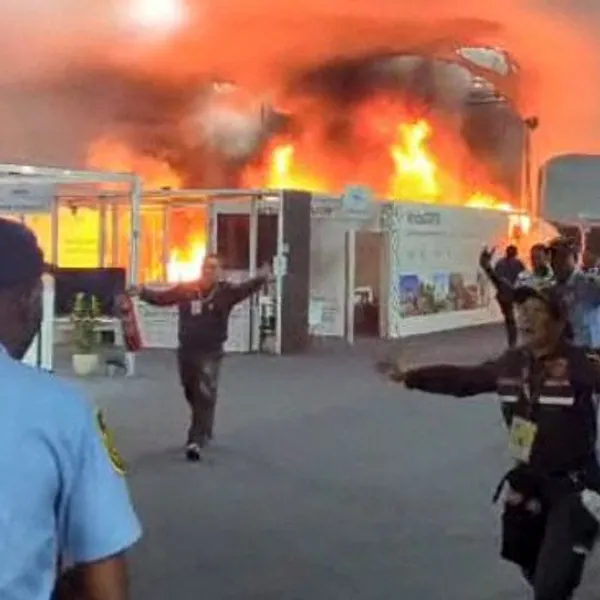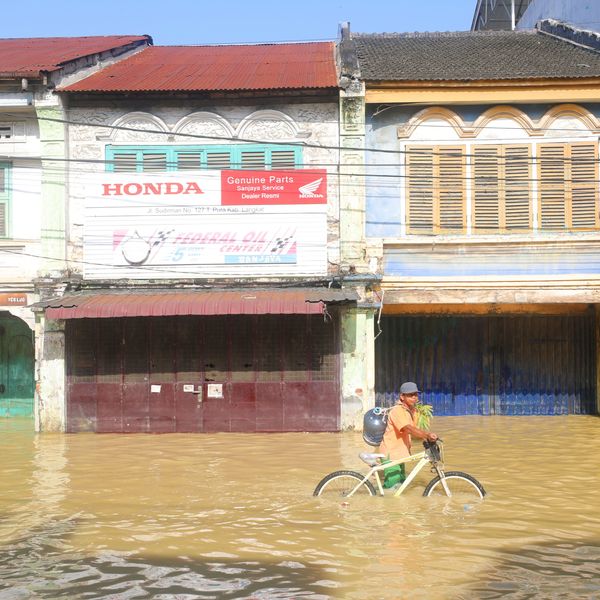
Residents look on as flames burn through the bush on January 04, 2020, in Lake Tabourie, Australia.
'Virtually Unstoppable' Blazes, Record Heat, and Mass Evacuations as Australia Wildfires Intensify
"We are still yet to hit the worst of it," said Gladys Berejiklian, premier of New South Wales.
Powerful winds and sweltering heat on Saturday combined to intensify catastrophic bushfires across Australia, forcing more than 100,000 people to evacuate their homes as firefighters struggled to contain the "virtually unstoppable" blazes ravaging large swaths of the continent.
At least two dozen people and an estimated half a billion animals have been killed by the fires, which have scorched more than six million hectares of land since September.
Australian authorities said Saturday and Sunday are likely to be two of the worst days since the fire season began late last year. "We are still yet to hit the worst of it," warned New South Wales Premier Gladys Berejiklian.
As the Associated Press reported Saturday, "the fire danger increased as temperatures rose to record levels across Australia on Saturday, surpassing 43 degrees Celsius (109 Fahrenheit) in Canberra, the capital, and reaching a record-high 48.9 C (120 F) in Penrith, in Sydney's western suburbs."
\u201c#Canberra has reached 43.6C\u2014a new hottest temperature record for any month. The previous Canberra records are 42.2C at Canberra Airport in 1968 and 42.8C at the now-closed Acton site in 1939. Observations at: https://t.co/8mMXbj9VGR\u201d— Bureau of Meteorology Australian Capital Territory (@Bureau of Meteorology Australian Capital Territory) 1578110868
According to CNN, three fires in the Omeo region in Victoria state combined overnight "to form a single blaze bigger than the New York borough of Manhattan."
Angus Barners, an incident controller at the Rural Fire Service in Moruya, NSW, told CNN that "we can't stop the fires, all we can do is steer them around communities."
\u201c"The entire sky has been turned this deathly shade of orange"\n\nThe BBC's Phil Mercer reports from a dust storm in New South Wales - the high winds are making conditions perilous for firefighters tackling Australia's bushfires\n\nhttps://t.co/gXPAKxtGGt\u201d— BBC News (World) (@BBC News (World)) 1578140799
Prime Minister Scott Morrison--who has faced fierce criticism from residents for failing to take sufficient action to confront the blazes--announced the 3,000 Australian Defense Force Reserve troops Saturday to help fight the devastating fires.
Defense Minister Linda Reynolds told reporters that it is the first time reservists have been called up "in this way in living memory and, in fact, I believe for the first time in our nation's history."
An Urgent Message From Our Co-Founder
Dear Common Dreams reader, The U.S. is on a fast track to authoritarianism like nothing I've ever seen. Meanwhile, corporate news outlets are utterly capitulating to Trump, twisting their coverage to avoid drawing his ire while lining up to stuff cash in his pockets. That's why I believe that Common Dreams is doing the best and most consequential reporting that we've ever done. Our small but mighty team is a progressive reporting powerhouse, covering the news every day that the corporate media never will. Our mission has always been simple: To inform. To inspire. And to ignite change for the common good. Now here's the key piece that I want all our readers to understand: None of this would be possible without your financial support. That's not just some fundraising cliche. It's the absolute and literal truth. We don't accept corporate advertising and never will. We don't have a paywall because we don't think people should be blocked from critical news based on their ability to pay. Everything we do is funded by the donations of readers like you. Will you donate now to help power the nonprofit, independent reporting of Common Dreams? Thank you for being a vital member of our community. Together, we can keep independent journalism alive when it’s needed most. - Craig Brown, Co-founder |
Powerful winds and sweltering heat on Saturday combined to intensify catastrophic bushfires across Australia, forcing more than 100,000 people to evacuate their homes as firefighters struggled to contain the "virtually unstoppable" blazes ravaging large swaths of the continent.
At least two dozen people and an estimated half a billion animals have been killed by the fires, which have scorched more than six million hectares of land since September.
Australian authorities said Saturday and Sunday are likely to be two of the worst days since the fire season began late last year. "We are still yet to hit the worst of it," warned New South Wales Premier Gladys Berejiklian.
As the Associated Press reported Saturday, "the fire danger increased as temperatures rose to record levels across Australia on Saturday, surpassing 43 degrees Celsius (109 Fahrenheit) in Canberra, the capital, and reaching a record-high 48.9 C (120 F) in Penrith, in Sydney's western suburbs."
\u201c#Canberra has reached 43.6C\u2014a new hottest temperature record for any month. The previous Canberra records are 42.2C at Canberra Airport in 1968 and 42.8C at the now-closed Acton site in 1939. Observations at: https://t.co/8mMXbj9VGR\u201d— Bureau of Meteorology Australian Capital Territory (@Bureau of Meteorology Australian Capital Territory) 1578110868
According to CNN, three fires in the Omeo region in Victoria state combined overnight "to form a single blaze bigger than the New York borough of Manhattan."
Angus Barners, an incident controller at the Rural Fire Service in Moruya, NSW, told CNN that "we can't stop the fires, all we can do is steer them around communities."
\u201c"The entire sky has been turned this deathly shade of orange"\n\nThe BBC's Phil Mercer reports from a dust storm in New South Wales - the high winds are making conditions perilous for firefighters tackling Australia's bushfires\n\nhttps://t.co/gXPAKxtGGt\u201d— BBC News (World) (@BBC News (World)) 1578140799
Prime Minister Scott Morrison--who has faced fierce criticism from residents for failing to take sufficient action to confront the blazes--announced the 3,000 Australian Defense Force Reserve troops Saturday to help fight the devastating fires.
Defense Minister Linda Reynolds told reporters that it is the first time reservists have been called up "in this way in living memory and, in fact, I believe for the first time in our nation's history."
Powerful winds and sweltering heat on Saturday combined to intensify catastrophic bushfires across Australia, forcing more than 100,000 people to evacuate their homes as firefighters struggled to contain the "virtually unstoppable" blazes ravaging large swaths of the continent.
At least two dozen people and an estimated half a billion animals have been killed by the fires, which have scorched more than six million hectares of land since September.
Australian authorities said Saturday and Sunday are likely to be two of the worst days since the fire season began late last year. "We are still yet to hit the worst of it," warned New South Wales Premier Gladys Berejiklian.
As the Associated Press reported Saturday, "the fire danger increased as temperatures rose to record levels across Australia on Saturday, surpassing 43 degrees Celsius (109 Fahrenheit) in Canberra, the capital, and reaching a record-high 48.9 C (120 F) in Penrith, in Sydney's western suburbs."
\u201c#Canberra has reached 43.6C\u2014a new hottest temperature record for any month. The previous Canberra records are 42.2C at Canberra Airport in 1968 and 42.8C at the now-closed Acton site in 1939. Observations at: https://t.co/8mMXbj9VGR\u201d— Bureau of Meteorology Australian Capital Territory (@Bureau of Meteorology Australian Capital Territory) 1578110868
According to CNN, three fires in the Omeo region in Victoria state combined overnight "to form a single blaze bigger than the New York borough of Manhattan."
Angus Barners, an incident controller at the Rural Fire Service in Moruya, NSW, told CNN that "we can't stop the fires, all we can do is steer them around communities."
\u201c"The entire sky has been turned this deathly shade of orange"\n\nThe BBC's Phil Mercer reports from a dust storm in New South Wales - the high winds are making conditions perilous for firefighters tackling Australia's bushfires\n\nhttps://t.co/gXPAKxtGGt\u201d— BBC News (World) (@BBC News (World)) 1578140799
Prime Minister Scott Morrison--who has faced fierce criticism from residents for failing to take sufficient action to confront the blazes--announced the 3,000 Australian Defense Force Reserve troops Saturday to help fight the devastating fires.
Defense Minister Linda Reynolds told reporters that it is the first time reservists have been called up "in this way in living memory and, in fact, I believe for the first time in our nation's history."

